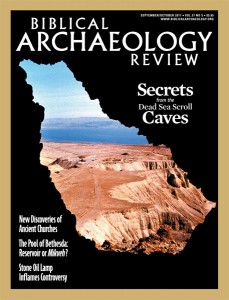A View from the Caves
Who put the scrolls in there?

The Dead Sea Scrolls were discovered in 11 caves in the Judean Desert near a site known as Khirbet Qumran, or the ruins of Qumran. Père Roland de Vaux of the École Biblique et Archéologique Française, who excavated the site in the 1950s, concluded that Qumran was a Jewish sectarian settlement, most probably Essene (the other two main Jewish movements in the Greco-Roman period being Pharisees and Sadducees). The Essenes from Qumran, who owned the scrolls, hid them in the caves during the Great Jewish Revolt against Rome (66–73 C.E.), he said, because the settlement was threatened by an advancing Roman legion, which indeed destroyed the site in 68 C.E.
This is still the most common view espoused by scholars, championed especially by the American archaeologist Jodi Magness, Magen Broshi, former curator of the Shrine of the Book where the major intact scrolls are housed, and the late Israeli archaeologist and scroll scholar Hanan Eshel.
Already a library member? Log in here.
Institution user? Log in with your IP address.

